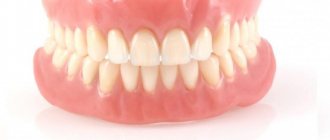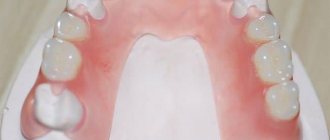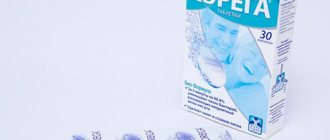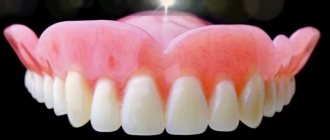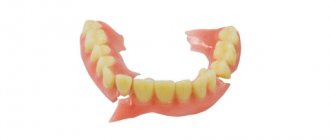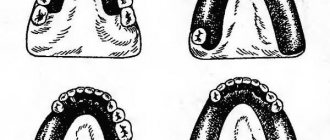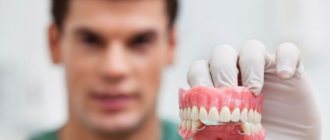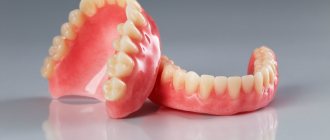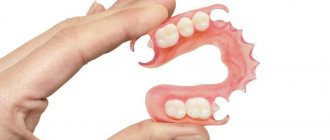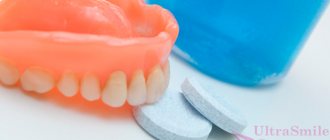How long can you wear without taking it off?
How to store? How to care? Whitening dentures Service life Dentures for many years You can restore the dentition in different ways, including removable dentures. They help restore the beauty of a smile, restore chewing function, and increase self-esteem. In order for restorations to retain their attractive appearance and last for several years, they must be looked after. Cleaning dentures and disinfecting them is an important part of care.
After installation, the dentist will definitely give recommendations on how to use dentures. He will warn that in the first days the restoration will interfere. It is necessary to prepare yourself psychologically and survive this time. It will become easier in a few days. Usually the hardest day is the first. Then a difficult 5-7 days
addictive, but they are not so intense. During this period, orthopedists advise not to remove the denture at night and generally remove it from the mouth only for cleaning.
These days, the patient practices his skills of taking off and putting on dentures, speaking when the tongue is cramped in the mouth, and chewing with unusually high teeth.
How long can you wear a prosthesis without removing it?
It is believed that the adaptation period has come to an end when the patient without dentures becomes uncomfortable. He already knows how to quickly put them on, they do not interfere with speaking, and are involved in chewing food. The period when it is better not to remove the structure is ending. Now you can take it out, but how often?
The standard recommendation is to remove the dentures at night to give your gums a chance to rest. If the denture is not removed, the hygienic condition of the oral cavity deteriorates. However, modern dentistry is characterized by an individual approach, so how often to remove dentures depends on specific circumstances. For example, with removable prosthetics, it is important how many antagonist teeth remain. In some cases, a prosthesis helps protect the remaining teeth from traumatic occlusion (touch) and overstrain. Do not remove splinted structures or restorations due to arthropathy and bruxism
[1].
The side effects of restoration can be compensated for by using prosthetic products without a palate and frequent cleaning.
Basic rule:
The less often the patient removes the prosthesis, the more carefully it needs to be looked after.
Do acrylic and nylon structures need to be removed at night?
Immediately after the manufacture and installation of a removable denture, the patient has to get used to it. The adaptation period passes faster if new teeth remain in the mouth around the clock. Therefore, after evening cleaning, you should put them back and go to bed. During night rest, the base and fastenings do not put pressure on soft tissues and supporting teeth, so it is easier for the jaws and mucous membranes to adapt to the unusual load.
After adapting to the design, it is also not necessary to remove it at night. Modern materials, unlike rubber, do not require constant hydration, so they can remain in the mouth even during night sleep. It is recommended to remove them only periodically to give the tissues a chance to rest. But in some cases, it is still undesirable to remove prosthetic modules at night in order to prevent displacement of the head of the jaw joint.
Since recommendations may be different for each situation, you should only rely on the advice of your dentist. If he suggests removing the structure, it is advisable to do so.
Foods to avoid
Proper care of dentures also means that you need to treat them with care. During the first time after installation, patients have to slightly change their diet. Although most foods will gradually return to your diet, some of them should be abandoned altogether. These are solid products: crackers, nuts, seeds, dried bread and bagels. Classified as unwanted
include toffee, nougat, and chewing gum. It is better to avoid food that is too hot to prevent cracks in the base.
At first, it is better not to bite off anything at all, then bite off with the side group of teeth, gradually moving to the front group.
It is important to chew food slowly, making sure that the chewing load is distributed evenly on both sides.
Tea, coffee, red wine and dark berries create conditions for discoloration of restorations. This should also be kept in mind when choosing drinks and food.
This is especially true for acrylic plastics. They are permeated with micropores in which pigments easily accumulate. More modern materials such as Acry Free or QuattroTi are dye resistant.
How to quickly get used to new dentures
- Immediately after submitting the finished work in the dentist’s chair, learn how to remove and put on removable dentures yourself. At home, practice again, first in front of a mirror, then without it.
- Before applying, soak removable dentures in water or use a fixative.
- For the first one and a half to two weeks after the application of dentures, they should not be removed from the mouth, even at night. Take them out only for cleaning and oral hygiene.
- To reduce the gag reflex, try sucking the candy by placing it towards the roof of your mouth and holding it in this position with your tongue.
- Rinse your mouth often with warm water (8-10 times a day) or drink hot tea.
- Reading aloud in a calm, relaxed atmosphere for 2 hours helps to quickly restore correct pronunciation. In most patients, diction is restored quite quickly (after 5-6 days)
- For the first 2-4 days of wearing the prosthesis, try to eat soft foods and not load the prosthesis until you fully adapt to it. Try not to bite with your front teeth. Chew your food slowly and thoroughly.
- Chew food with your side teeth at the same time (left and right at once). Cut food into small pieces. Introduce more fruits and vegetables into your diet (this will allow you to switch to your usual diet earlier).
How to store
The best place to store dentures is in a special container. As a last resort, you can put it in a glass of water or wrap it in a damp cloth. To store dentures at night and between uses:
- away from children and animals;
- in a special solution or cooled boiled water. Do not immerse in boiling water or tap water, which contains many impurities.
Whether to place the product in water or a special storage solution largely depends on the material
. Modern thermoalloys do not need a humid environment, but classic acrylic ones can dry out without water. Your dentist will advise you on how to properly store dentures, taking into account the material of construction.
Features of using a removable denture
No matter how perfect the prosthesis is, it must be removed and cleaned regularly. It is uncomfortable to sleep with, so it should be stored separately at night. You need to take care of artificial teeth no less carefully than you take care of your own, otherwise very soon an unpleasant odor, stains and plaque will appear on the surface.
For this reason, every morning and before bed, hygienic treatment of the dental structure and oral cavity is carried out.
Hygienic treatment of dentures
| Cleaning methods | Description | Frequency of application |
| Washing with water | The product is thoroughly washed under running water. It is advisable not to use tap water; it is better to take boiled water at room temperature. Please note that this measure does not ensure absolute cleanliness. | Every time after eating |
| Cleaning with a brush and special paste | Thin, hard bristles allow you to remove not only food debris from the denture, but also effectively remove the resulting plaque. Wash off the paste with boiled water | Every morning and evening |
| Treatment with antiseptic liquid | Before soaking in the solution, the denture is cleaned with a brush and washed in water. This method allows you to remove bacteria from the surface and remove any remaining fixing cream. | Once a day (at night) |
| Professional cleaning of dental equipment | Performed only by specialists in the clinic | At least once every six months |
How to care for dentures
A side effect of removable dentures is a change in the microflora of the oral cavity. Because of the prosthesis, the palate and gums stop cleaning themselves. Bacteria accumulate in the mouth, especially at the points of attachment to the crown of the tooth, if the structure is partial. The longer a restoration is used, the more it is exposed to biocontamination.
Proper care has a great impact on the service life of removable structures. It is multi-stage, but in reality it does not require much time and effort.
In dentistry, there are mechanical, chemical, and physical methods of cleaning restorations.
Mechanical cleaning
carried out with a special toothbrush. The fact that it has bristles on both sides helps to effectively clean removable dentures from plaque. The longer one is for processing the outside, and the short one is for the inside. The heads are either straight or crescent-shaped.
An orthopedic dentist will definitely tell you how to clean your dentures. The brush should be soft, usually written “soft” on the packaging, and the paste should be low-forming. The abrasiveness coefficient is indicated on the packaging under the letter RDA
.
For nylon and Acry Free bases, it is best to choose a paste with zero abrasiveness
. These are produced for children under 3 years of age. Instead of toothpaste, you can use liquid soap.
Acrylic bases can be cleaned with a paste with an abrasiveness of up to 25
. For ordinary pastes, this coefficient is 60 or higher. Whitening pastes are not recommended.
Chemical cleaning
- This is soaking in disinfectant solutions. The structure is immersed in the prepared solution or a special tablet is added to the water. Such products are sold in pharmacies. The most famous brands: Corega and Protefix. These products destroy bacterial plaque, which can cause diseases of the mucous membrane and cause an unpleasant odor from the prosthesis. After being in the solution, the structure emits a pleasant aroma.
However, in case of heavy contamination, such disinfection does not provide 100% cleaning. If a layer of pigment or tartar has formed on the product, home care tablets for removable plastic dentures will not help. Here they use polishing at the dentist or ultrasound.
Physical cleaning
Ultrasound is suitable for complete dentures made of any material. Ultrasound passes through the liquid, creating bubbles on the surface of the restoration, which, when bursting, help clear plaque on the dentures, clean them of food debris and dirt, even from hard-to-reach places. 10-20 minutes in such a bath and not a trace remains of bacterial plaque. The higher the power of the ultrasonic bath, the better it cleans the surface.
After each meal, it is recommended to rinse the restoration under running water. The cleaner the denture, the more comfortable it feels in the mouth. A structure covered with plaque and stains wears out faster. In addition, dirt and bacterial film provoke inflammatory processes in the oral cavity. With proper and regular use of cleaning products, restorations retain their attractive appearance for a long time.
If the structure has become dull and shows signs of pigmentation, you can contact your dentist and he will send the denture for polishing.
Solutions for storing and caring for removable dentures
Previously, products with potassium permanganate and soda were used for these purposes. Today, this approach is a thing of the past, since these substances can cause harm.
Modern compositions are divided into:
- fixing (gel, cream, glue), thanks to which the structures fit tightly to the gums without falling off, including when eating. They also help prevent food from getting under the products. If it accumulates, it will become a medium for the development of microbes;
- Cleansers – products used as part of recommendations on how to properly store removable dentures at night.
The latter are represented by antiseptic compounds that are used to thoroughly clean structures from plaque, food debris, and pathogenic microorganisms. To do this, they should be soaked in the solution once a week for 5–15 minutes. Afterwards they are removed, washed, dried, and wiped with a napkin.
Such formulations are produced in the form of liquids and tablets that need to be diluted with water. Representatives of the former are Curaprox weekly, Orthosol-Dent. From the second category, the drugs Protefix and Corega are popular. But it is better to make the choice on the recommendation of a doctor.
Proper storage and care of removable dentures ensures their long service life. In addition, this is the key to the health of the entire oral cavity.
Whitening dentures
Pigmentation and brown deposits can ruin the appearance of any restoration. Regular oral care with dentures prolongs the life of the dentures and maintains the aesthetics of the structure. But whitening pastes only cause harm. They contain too many abrasives that scratch the plastic. The surface of artificial teeth is not as strong as that of natural teeth and is easily damaged.
The acids in home whitening kits are simply dangerous. The reaction of their components with prosthetic materials can lead to unpredictable, life-threatening results.
To whiten dentures at home, it is better to use special products. For example, Corega whitening tablets. They carefully clean the surface without harming it, eliminate unpleasant odors and remove stains. The tablets slightly lighten artificial teeth, simultaneously destroying pathogenic microflora,
How long does it take to get used to removable dentures?
On average, 30 days. At the beginning of use, removable dentures feel like a foreign body and can cause discomfort. They can interfere with the production of sounds (diction), cause increased salivation, changes in taste and temperature sensations, and difficulty biting and chewing food. Sometimes, when applying removable dentures, the urge to vomit may occur. It is also possible that the dentures do not adhere satisfactorily, or food debris gets underneath them, or biting the cheeks, lips, or tongue. All these phenomena decrease by the end of the first week of wearing the prosthesis and disappear after 3-4 weeks. After an adaptation period, the patient already feels more comfortable with prostheses than without them.
The main condition for quickly getting used to prostheses is their constant use. The rules and recommendations below will help you shorten the adaptation period.
Life time
If you wear your denture correctly and take good care of it, it will retain its original appearance for a long time. But after a maximum of 5 years
it will still have to be changed. This is due to the fact that removable dentures do not stop bone loss. Over the years, the gums sag, the topography of the mouth changes and the prosthesis no longer fits. In the first years, correction and relining help, but over time, the changes become so pronounced that only a new prosthesis can save the situation.
Which solutions are suitable for storage
Solutions - ready-made liquids or made from water and special cleaning tablets, are suitable only for caring for clasp dentures, but not for storage. Moreover, effervescent tablets are more popular, because take up less space and are more convenient to take with you. To clean the orthopedic structure, manufacturers suggest dissolving the tablet in a glass or container with clean water at room temperature. Then you should place the prosthesis in a container and leave it for 3 to 15 minutes (each brand has its own operating time). Then the “clasp” is removed, cleaned with a brush, washed in running water and dried. After these manipulations, you can install it on the jaw, but the solution must be poured out.
Popular brands of cleansing tablets are Corega, PresiDENT, Protefix, ROCS BONY plus Express, LACALUT DENT Reinigungs Tabs.
What to choose if you are completely missing teeth
If the doctor has not identified any contraindications, separate implants are recommended. However, you can look towards removable or partially removable options.
Partial absence
Conducive to installing butterflies and crowns. Any of the methods described in the article is suitable for replacing a bite. Only a qualified specialist can provide the correct advice in each specific case.
For the upper and lower parts of the mouth
If we are talking about removable structures, plate options can be used at the top, and fixed ones at the bottom. This advice is based on the anatomical features of the jaw. However, only the doctor will provide the correct solution.
Features of storage of the clasp design
How to store a partial denture outside the mouth, for example, at night or during dental treatment? Ideally, you will not remove it from your mouth at all. But if removal is necessary, it is better to have a special container on hand. Such containers are made specifically for storing removable dentures. Inside the container there may be a holder curved in the shape of a jaw - so that the product does not move inside and does not scratch the walls.
Read on the topic: a container for storing removable dentures - what it can be and which one is better to choose.
After removal, the “clasp” must be cleaned and rinsed with water, gently wiped with a clean napkin and stored in a container. In the same container you can soak in the cleaning solution (if the instructions for the container do not prohibit this). For example, the container can be “double-layered” - with a mesh immersed in the container, and also equipped with an ultrasonic cleaner. For long-term storage, containers with ventilation holes are suitable so that excess moisture can evaporate without problems and not settle inside.
“I stored my bugel in a regular food container. Well, I screwed the lid tightly. Then I realized that I shouldn’t have done this, because... an unpleasant odor appeared. I decided not to close the lid, but I became afraid that someone would sweep the container off the table and the “jaw” would break. Then I decided not to suffer and buy a special case.”
Olga Sergeevna, review from otzovik.com
It is important to place the container with the clasp denture in a suitable place - a shelf in a closet or bedside table is quite suitable. There should be no sources of heat or moisture nearby - a radiator, stove, water tap or humidifier. It is better not to leave the prosthetic structure in the bright sun, because... the material may become discolored. Another danger is posed by sharp objects, unstable massive structures - a hanging shelf with knives, a stack of books, a vase with a bouquet of flowers, etc. Place container behind closed doors, out of reach of small children or pets.
1Gromov O.V. “Lock fastenings in clasp prosthetics, 2010.
Your questions and answers
QUESTION Hello, I’ve been wearing a clasp denture for 2 weeks now, but I still don’t understand how to store it? I put it in water overnight a couple of times, but then I stopped. I don’t remember what the doctor said about this... Evgenia
ANSWER Hello, Evgenia. In general, you don’t even have to remove your clasp denture for now and “store” it directly in your mouth. Because the main task in the first weeks is to get used to the artificial structure. And the more time it “spends” in your mouth, the faster you will get used to it. As for storing clasp dentures in water, absolutely all orthopedic dentists do not advise leaving modern dentures for a long time in any liquid. Maximum – 15-30 minutes a day. Excessive moisture can damage the material, and your prosthesis will quickly become unusable and you will have to make a new one.
Author: Dulgarov Zh. G. (Thank you for your help in writing the article and the information provided)
